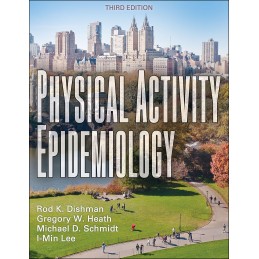Physical Activity Epidemiology, Third Edition, provides a discussion of current studies showing the influence of physical activity on disease. Updated with extensive new content in alignment with the 2018 Physical Activity Guidelines Advisory Committee Scientific Report, the third edition benefits from the expertise of authors Rod Dishman, Gregory Heath, Michael Schmidt, and I-Min Lee. These authors offer insight gained from their professional experiences, which include leadership roles within the Centers for Disease Control and Prevention, contributions to the
2008 Physical Activity Guidelines for Americans, and a combined 1,000 peer-reviewed articles in high-impact journals across each of their disciplines.
Physical Activity Epidemiology, Third Edition, explores how physical activity can enhance quality of life. The text summarizes the available knowledge, examines the methods used to obtain these findings, considers the implications for public health, and outlines the important questions that remain. Readers will find comprehensive discussions of these topics::
- Part I introduces physical activity epidemiology and provides an extensive background in research methods as well as physical activity measurement and surveillance.
- Part II focuses on the evidence that physical activity protects against premature death from all causes and inhibits the development of coronary heart disease and stroke.
- Part III offers population-based studies and clinical experiments providing evidence that physical activity plays a role in the prevention of hypertension, dyslipidemia, and obesity.
- Part IV compiles the latest data on two chronic diseases that are increasing in prevalence worldwide:: type 2 diabetes and osteoporosis.
- Part V describes the evidence that physical activity is associated with reduced risks of certain cancers and explores the use of immunotherapy in cancer treatment.
- Part VI addresses mental health and the promotion of a safe, physically active lifestyle among all segments of the population.
The third edition of this text offers expanded coverage of the measurement of sedentary behavior; the effects of physical activity on osteoporosis and bone health, cancers, and inflammatory diseases; and the potential of exercise to complement immunotherapy in cancer treatment. More than 200 tables and figures highlight information in an easy-to-understand visual format.
Physical Activity Epidemiology, Third Edition, examines the methodology and findings of classic and contemporary studies and then helps students analyze the results. The special Strength of the Evidence sections summarize the findings to determine the extent to which correlation and causation can be proven. Chapter objectives, chapter summaries, sidebars, and a glossary assist students in finding key information. Instructors will find a test package, image bank, and downloadable learning activities to assist with student comprehension.
Physical Activity Epidemiology, Third Edition, offers a comprehensive presentation of significant studies, discusses how these studies contribute to understanding the relationship between activity and disease prevention, and explores how this information can be used in leading global society toward increased health and longevity.




 Delivery policy
Delivery policy
 Security policy
Security policy
 Return policy
Return policy
